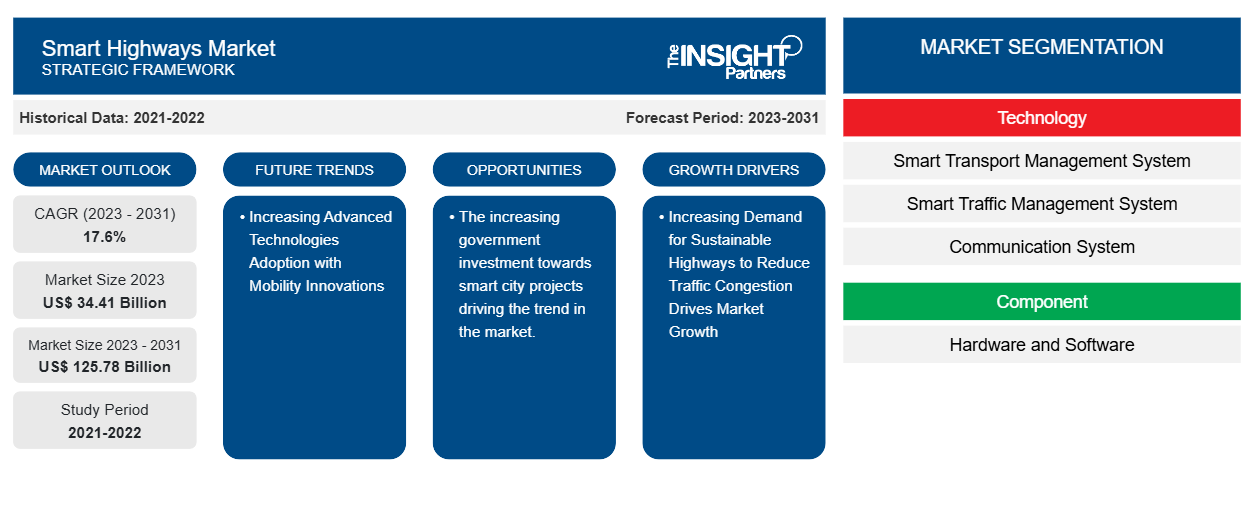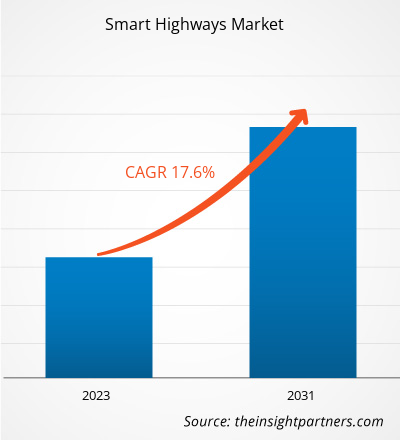The smart highways market size is projected to reach US$ 125.78 billion by 2031 from US$ 34.41 billion in 2023. The market is expected to register a CAGR of 17.6% during 2023–2031. The increasing government initiatives for smart city development drive market growth. Increasing adoption of advanced technologies for smart city establishment across the globe is a driving trend in the market.
Smart Highways Market Analysis
Increasing development of smart highways with the integration of advanced technologies, such as artificial intelligence, Internet of Things, and connected devices, in the transportation roadways drives the smart highways market growth. There are various governing bodies that plans to modify their routes, especially highways to support the intelligent transportation systems and road infrastructure across the globe. For instance, in Europe, Cooperative Intelligent Transport Systems built for smart roads that allows the road users and traffic managers to coordinate and share helpful information for about the road activities.
Smart Highways Market Overview
Rising adoption and project development of the “Smart city” in urban areas with integration of extensive sensors network to promote better connectivity drives the market growth. The smart cities around the world are undergoing significant changes to make the lives of citizens better, more efficient, and eco-friendly. Innovations such as smart city construction are anticipated to bolster the market for smart highways significantly in the years to come.
With projects from both the public and private sectors, New York City is currently undergoing digital transformation with cutting-edge technology offered by the Internet of Things and connected devices.
Customize This Report To Suit Your Requirement
You will get customization on any report - free of charge - including parts of this report, or country-level analysis, Excel Data pack, as well as avail great offers and discounts for start-ups & universities
Smart Highways Market: Strategic Insights

-
Get Top Key Market Trends of this report.This FREE sample will include data analysis, ranging from market trends to estimates and forecasts.
Smart Highways Market Drivers and Opportunities
Increasing Demand for Sustainable Highways to Reduce Traffic Congestion Drives Market Growth
A sustainable highway enables societal development and economic growth and reduces negative impacts on the environment. According to the Federal Highway Administration (FHWA), sustainable highways are an integral part of sustainable development that should be assessed and considered for implementation throughout its lifecycle, from design through construction, operations, and maintenance. In addition to addressing environmental and natural resource needs, a sustainable highway caters to the demand for accessibility of transportation services and safe and comfortable walking, cycling, and transit routes. Highway authorities in the US are addressing sustainability through a wide range of initiatives, such as intelligent transportation systems (ITS), recycling, planning, environment linkages, and the National Environmental Policy Act (NEPA) requirements.
Increased government spending on construction and road infrastructure will offer more opportunities for North America's Smart Highway market. The public construction spending on the high way and street projects in the US reached US$ 95.5 billion in 2021, according to the US Department of Transportation. Also, as per the US Department of Transportation around US$ 350 million have been invested in the public and private funds for the smart city developments.
Increasing Advanced Technologies Adoption with Mobility Innovations
Various technologies, such as ad-hoc mesh Wi-Fi and Cellular Vehicle-to-Everything (C-V2X), keep the drivers informed of the changes in traffic lights and communicate with other vehicles to avoid collisions. Innovations in digital technologies are anticipated to provide lucrative growth opportunities for the smart highway market players during the forecast period. Governments across the globe are significantly investing in connected vehicle technologies to boost the smart highway market growth. For instance, The Colorado Department of Transportation plans to equip 2,500 government vehicles with C-V2X and Dedicated Short-Range Communications (DSRC) technologies in 10 years. In China, C-V2X is widely adopted by the government as a key enabler of connected vehicles as they provide broad coverage.
Smart Highways Market Report Segmentation Analysis
Key segments that contributed to the derivation of the Smart Highways market analysis are disc technology, components, and geography.
- Based on technology, the market is divided into smart transport management systems, smart traffic management systems, communication systems, monitoring systems, and others. Among these, smart transport management systems had the largest share in 2023. This is owing to increasing investment in smart cities with government initiatives.
- Depending upon the component, the market is divided into hardware and software. Among these, the hardware segment has a larger share in 2023. This is owing to increasing investments in smart cities.
Smart Highways Market Share Analysis by Geography
The geographic scope of the smart highways market report is mainly divided into five regions: North America, Asia Pacific, Europe, Middle East & Africa, and South America.
North America is expected to have the largest share in 2023. This is primarily owing to increasing investments in the highway to pay for bridges, toll roads, and tunnels. There are over 300 facilities across the US that transform the region's road transportation and highway scenario. According to Toll Miner Data Visualization tools, there are more than 114 operators that run more than 321 tolled facilities in the US. This uses ETC, covering a whopping 6,235 center-line miles of roadway. Therefore, the large-scale adoption of automated tolling systems, which eliminates cash payments (and toll plazas) from the facilities, encourages the successful implementation of other components and technologies of smart highways in North America.
Smart Highways Market Regional Insights
The regional trends and factors influencing the Smart Highways Market throughout the forecast period have been thoroughly explained by the analysts at The Insight Partners. This section also discusses Smart Highways Market segments and geography across North America, Europe, Asia Pacific, Middle East and Africa, and South and Central America.
Smart Highways Market Report Scope
| Report Attribute | Details |
|---|---|
| Market size in 2023 | US$ 34.41 Billion |
| Market Size by 2031 | US$ 125.78 Billion |
| Global CAGR (2023 - 2031) | 17.6% |
| Historical Data | 2021-2022 |
| Forecast period | 2023-2031 |
| Segments Covered |
By Technology
|
| Regions and Countries Covered |
North America
|
| Market leaders and key company profiles |
|
Smart Highways Market Players Density: Understanding Its Impact on Business Dynamics
The Smart Highways Market is growing rapidly, driven by increasing end-user demand due to factors such as evolving consumer preferences, technological advancements, and greater awareness of the product's benefits. As demand rises, businesses are expanding their offerings, innovating to meet consumer needs, and capitalizing on emerging trends, which further fuels market growth.

- Get the Smart Highways Market top key players overview
Smart Highways Market News and Recent Developments
The smart highways market is evaluated by gathering qualitative and quantitative data post primary and secondary research, which includes important corporate publications, association data, and databases. A few of the developments in the Smart Highways Market are listed below:
- Two roads were developed under the smart city project in India, with the capital opened to the public. The smart highways built from Althara to Chenthitta via Vazhuthacaud and Thycaud will be completed by the end of April 2024. The Killipalam-Attakulangara Road was completed by the second week of May 2024. (Source: Times of India-Newsletter, March 2024)
- Iteris, Inc., the world’s trusted technology ecosystem for smart mobility infrastructure management, today announced that Carson City, Nevada, US, has chosen to upgrade the city’s intersection detection sensors to Iteris’ Vantage Apex hybrid sensors. Vantage Apex is the industry’s first 1080p high-definition (HD) video and four-dimensional (4D) radar sensor with integrated artificial intelligence (AI) algorithms. It delivers state-of-the-art detection, tracking, and classification accuracy of vehicles, pedestrians, and cyclists, as well as HD video display for traffic management center monitoring. (Source: Press Release, April 2024)
Smart Highways Market Report Coverage and Deliverables
The “Smart Highways Market Size and Forecast (2021–2031)” report provides a detailed analysis of the market covering below areas:
- Smart highways market size and forecast at global, regional, and country levels for all the key market segments covered under the scope
- Smart highways market trends as well as market dynamics such as drivers, restraints, and key opportunities
- Detailed PEST and SWOT analysis
- Smart highways market analysis covering key market trends, global and regional framework, major players, regulations, and recent market developments
- Industry landscape and competition analysis covering market concentration, heat map analysis, prominent players, and recent developments for the smart highways market
- Detailed company profiles
Frequently Asked Questions
Which region dominated the smart highways market in 2023?
What are the driving factors impacting the smart highways market?
What are the future trends of the smart highways market?
Which are the leading players operating in the smart highways market?
What would be the estimated value of the Smart Highways market by 2031?
What is the expected CAGR of the smart highways market?
- Historical Analysis (2 Years), Base Year, Forecast (7 Years) with CAGR
- PEST and SWOT Analysis
- Market Size Value / Volume - Global, Regional, Country
- Industry and Competitive Landscape
- Excel Dataset
Recent Reports
Testimonials
Reason to Buy
- Informed Decision-Making
- Understanding Market Dynamics
- Competitive Analysis
- Identifying Emerging Markets
- Customer Insights
- Market Forecasts
- Risk Mitigation
- Boosting Operational Efficiency
- Strategic Planning
- Investment Justification
- Tracking Industry Innovations
- Aligning with Regulatory Trends





















 Get Free Sample For
Get Free Sample For